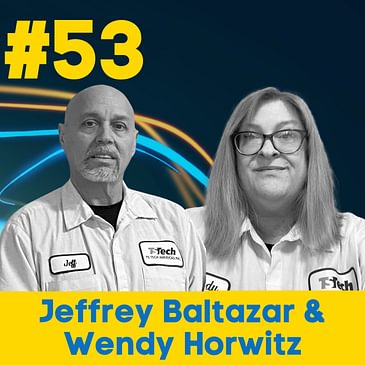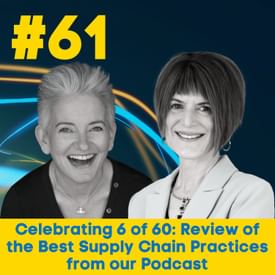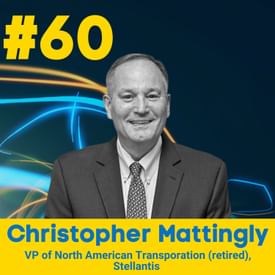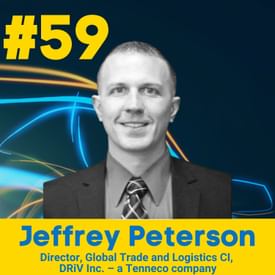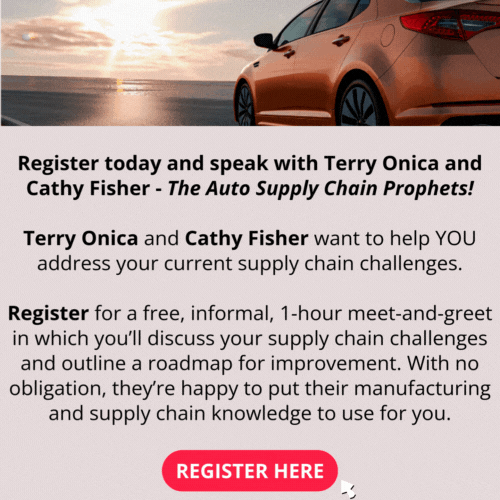In this episode of the Auto Supply Chain Prophets Podcast, hosts Terry Onica and Jan Griffiths discuss the importance of improving supply chain efficiency in the auto industry. They are joined by Wendy Horwitz, Corporate MMOG/LE Senior Manager, and Jeffrey Baltazar, Vice President of Manufacturing at TS Tech Americas, Inc., to talk about the challenges and benefits of embracing change and implementing MMOG/LE standards.
The conversation focuses on TS Tech's MMOG/LE journey. Jeffrey discusses the challenges of obtaining executive management commitment, particularly in a culturally diverse organization like TS Tech. He stressed the importance of showing the benefits of MMOG/LE in terms of efficiency and cost savings.
Wendy elaborates on the role of education and communication in garnering employee buy-in, stressing the need for understanding and alignment with company goals. She highlights the significance of leadership support and the establishment of dedicated teams to drive the implementation process.
They explore practical aspects of TS Tech's initiatives, including developing internal tools and systems to facilitate compliance and performance tracking. Wendy explains how they use the tools to automate processes and enhance visibility across multiple locations.
Jeffrey and Wendy encourage listeners to start their MMOG/LE journey early and emphasize the competitive advantage it brings. Additionally, they advise leaders to be proactive in embracing change and to see it as an opportunity to grow and improve.
Themes discussed in this episode:
- Updating standards and practices for supply chain efficiency.
- The importance of standards like MMOG/LE in the manufacturing process.
- The crucial role of top management support for successful supply chain initiatives.
- Utilizing technology to streamline supply chain processes and enhance visibility.
- Empowering employees through training and involvement in process improvement.
- Overcoming cultural barriers to foster collaboration and alignment.
- The significant value of continuous learning and evaluation for sustained success.
- Advantages of adopting supply chain standards early for competitive advantage.
Featured on this episode:
Name: Jeffrey Baltazar
Title: Vice President of Manufacturing at TS Tech Americas, Inc.
About: Jeffrey is the Vice President of Manufacturing at TS Tech Americas, Inc. With a strong focus on continuous improvement and customer satisfaction, Jeffrey leverages his expertise in manufacturing, lean manufacturing, operations management, engineering, and more to drive excellence in operations. Endorsed by colleagues for his proficiency in various areas, including Six Sigma, ISO standards, and value stream mapping, Jeffrey is committed to optimizing processes and enhancing efficiency within the automotive industry.
Connect: LinkedIn
Name: Wendy Horwitz
Title: Corporate MMOG/LE Senior Manager at TS Tech Americas, Inc.
About: Wendy serves as the Corporate MMOG/LE Senior Manager at TS Tech Americas, Inc. With a focus on spearheading the development of a new Corporate MMOG/LE program for the Americas Region, Wendy brings extensive experience and strategic vision to her role. Her leadership and expertise drive innovation and efficiency, ensuring the organization meets and exceeds industry standards. With a passion for excellence and a commitment to continuous improvement, Wendy plays a pivotal role in shaping the future success of TS Tech Americas, Inc.
Connect: LinkedIn
Mentioned in this episode:
- Episode with Matt Pohlman: Driving the Future: AIAG's Leadership in the EVolving Industry
- (MMOG/LE) Materials Management Operations Guideline/Logistics Evaluation
- AIAG’s Global MMOG/LE Implementation Training - 6th Edition
- AutoCulture 2.0: Leading with Gravitas by Jan Griffiths
Episode Highlights:
[02:39] Executive Commitment: Discussion on the strategies for gaining executive buy-in and team alignment in supply chain initiatives.
[08:44] Internal Tool Creation: TS Tech's innovative approach to enhancing MMOG/LE implementation with a custom tool.
[11:35] Executive Engagement: Addressing the significance of executive engagement and its impact on successful implementation.
[13:44] Technology Integration: Exploring the role of technology, particularly ERP systems, in enhancing supply chain efficiency and coordination.
[15:18] Training Impact: Examining the effects of on-site training on team collaboration and breaking down organizational silos.
[18:26] Wendy and Jeffrey’s advice: A call to embrace the challenge and prioritize implementing supply chain standards like MMOG/LE sooner rather than later to gain a competitive advantage and avoid being left behind.
Top Quotes:
[05:09] Wendy: “Taking the time and starting with education, making sure that everybody understood why we were doing this. You can tell people it's because of compliance or because a customer wants it or whatever, but you really need to have people understand the foundation and what's in it for them and how this is going to make their life easier.”
[11:55] Jeffrey: “With the labor situation and how hard it is to get people, the more efficient we can be throughout the complete manufacturing process is an ultimate gain. So, as we show those efficiencies, the one thing that we're uncovering is the redundant work that we do with all these multiple spreadsheets. We've got three or four people basically doing the same thing in a different spreadsheet to double-check. Instead of leveraging those systems that are out there, that is data in, data out.”
[09:16] Wendy: “One of the big tenets of MMOG/LE is to automate. The less Excel sheets and manual processes, the better. So, one of our big pushes is to utilize technology as much as we possibly can.”
[18:53] Wendy: “Start now. Don't wait for a customer to come to you and say it's a requirement. Don't wait for the industry to force you into it. You need to get started. I guarantee however long you think it's going to take, it's going to take longer if you're going to do it right because it’s, like you mentioned, it takes laying the groundwork and the training.”
[20:19] Jeffrey: “I would challenge them to take the challenge. Embrace the challenge. There will be benefits reaped in the end. And always remember that your competitors aren't waiting. So, embrace that challenge for change. Look for those efficiencies improvements and the material side is also always overlooked, but there's a lot of opportunity there.”
[Transcript]
[00:00:00] Jan Griffiths: This is the Auto Supply Chain Prophets podcast, where you'll hear from experts of all facets of supply chain in the auto industry to help you prepare for the future. I'm Jan Griffiths, your co-host and producer.
[00:00:17] Terry Onica: I'm Terry Onica, your podcast co-host. Let's dive in.
[00:00:23] Jan Griffiths: Hello and welcome to another episode of the Auto Supply Chain Prophets podcast. Let's check in with my co-host, Terry Onica. Terry, what have you been up to?
[00:00:31] Terry Onica: Well, I'm excited. This weekend, to me starts the official running season for me. I'm running the Rock CF Half Marathon. I love it. It kicks off the year, and we'll be running the rest of the year until probably about late November, and then we're done. But this is kind of the official kickoff to the running season. So, I'm excited.
[00:00:52] Jan Griffiths: That's awesome. Well, as you know, unless you've been living under a rock and you haven't looked at LinkedIn lately, you'll know that I launched my book last week.
[00:01:00] Terry Onica: Yay!
[00:01:01] Jan Griffiths: Finally, AutoCulture 2.0 is out there in the universe, and we all know that we need an upgrade to our operating system as regards culture in our beloved auto industry. So, it's there, and we'll put a link in the show notes. And the other episode that we have recently released on this very podcast is with Matt, who is the CEO of AIAG, and AIAG is heavily involved in MMOG/LE. And with us today, we have a rockstar company. That is really taking MMOG/LE to the next level and ingraining it in their culture. It's one thing to say that you're on board with a standard, or you've embraced something, or you're implementing a new technology, but it's those companies that really know how to ingrain it into their culture. That's what makes a rockstar company. That's what allows a company to succeed, to be successful, and to sustain in the future, and the future, as we know it in this industry, is changing by the minute. So, let's get right into it and let's introduce our guests today. We have Wendy Horwitz, who is the Corporate MMOG/LE Senior Manager. Wendy, welcome to the show.
[00:02:26] Wendy Horwitz: Thank you very much. Glad to be here.
[00:02:28] Jan Griffiths: And we have Jeff Baltazar, and Jeff is the VP of Manufacturing, and they both work for TS Tech. Welcome, Jeff.
[00:02:37] Jeffrey Baltazar: Thank you. I'm glad to be here.
[00:02:39] Terry Onica: So, Wendy and Jeff, I've worked with a lot of companies over the years with MMOG/LE. And I have to say, TS Tech is the first company that I've ever worked with that has really done it right from the beginning. So, can you walk us through getting that executive management commitment and getting the team on board, and some of the things that you did to have such success in your implementation of it right now?
[00:03:03] Jeffrey Baltazar: Yeah, Terry, as you know, we are a Japanese-owned company, so there are some cultural differences that we had to overcome — a lot of that is that total consensus way of decision making, so making them understand that our top management both here in the US and in Japan, basically, what's in it for me? What do we really are going to gain out of this? So, there was a lot of conversation back and forth. And of course, as we try to grow our business, like everyone else is, some of our customers' demands also influence that decision. But once it was decided that we wanted to embrace this culture, as there was opportunities to better control our material side, is we do a very good job on production efficiencies. But sometimes the material side is kind of laid second ground. So, introducing those ideas on what's in it for them, what we can gain really bridge that gap. And we got that consensus from our top management.
[00:04:11] Jan Griffiths: Did that take a long time, Jeff, to get to that point? 'Cause I think so often companies race to implementation without putting in place the building blocks and the foundation. I'm just curious how long it took you.
[00:04:25] Jeffrey Baltazar: The MMOG part is kind of more recent, but the implementation of those controls and such has been going on for a couple of years. Again, for the most part, our company is run by engineers. So, they're all about OEE on the equipment side, but they don't always see the complete value stream. So, educating on them, that's been years in the making, so it hasn't happened overnight.
[00:04:53] Terry Onica: And Wendy, so what have you done with the team to get them to rally around MMOG/LE and get the success that you're having today of the buy-in and the implementation of the MMOG/LE assessment?
[00:05:04] Wendy Horwitz: Sure. I think what Jeff said was a big part of it: taking the time and starting with education, making sure that everybody understood why we were doing this. You can tell people it's because of compliance or because a customer wants it or whatever, but you really need to have people understand the foundation and what's in it for them and how this is going to make their life easier, and those improvements and what we found is that the people that we have are amazing and they all want to do their best job and anytime the company is willing to invest and give them tools to do those things, we find that even if it's a little slow at first, they usually end up embracing because change is never easy for anyone because generally, it means more work, but they understand very well that putting that in at the front end is really going to help things on the back end. And I'd say one other thing that was very visual for them was the company's dedication to create the MMOG/LE team. I was put in place to focus solely on this topic and building these teams and the systems. And I think that means a lot when people can see they're not just saying, 'Oh, go do this.' They were really putting their money where their mouth is and saying, 'This is serious. We want to support you, and we're here to give you the tools you need to be successful.'
[00:06:35] Jan Griffiths: That's leadership. It comes back to leadership and culture. It absolutely does. I have a question that I want to go back to because we're already a few minutes in, and we've talked about the success of MMOG/LE, but Jeff, I have a question for you. What does that mean? What does success mean?
[00:06:53] Jeffrey Baltazar: So, again, it's for me in a management role in a leadership role is all about overall efficiencies. And what's at lay for the groundwork ahead of time? But again, we have to measure things in dollars and cents, of course. So, if we have better control of our complete supply chain and can control those inventories, it really impacts the bottom line. And we're already starting to see that as we measure inventory turns ratio to all of our plants. And we're approaching benchmark level at each one of our tier one facilities right now. So, we routinely are at 50, 55 inventory turns. That's what we're seeing right now. And that all translates to money.
[00:07:43] Jan Griffiths: Jeff, I have to ask you this question. You're a manufacturing guy, right?
[00:07:49] Jeffrey Baltazar: Yes.
[00:07:49] Jan Griffiths: You've had to really embrace supply chain and material flow in your plants. There are so many manufacturing leaders out there that would rather just blame the function rather than embrace the function and bring it together collaboratively. Was there a switch that went off in your brain that all of a sudden you became more collaborative, or what happened? How does that happen?
[00:08:12] Jeffrey Baltazar: Well, it's just, through the years, I've worn multiple hats, and I did take over one of our largest tier one facilities. I was in charge of supply chain. So, I went from the manufacturing side and was given, here you get all the material side, so including procurement, logistics, and even internal logistics. So, I grew very fond of understanding that complete value stream and the value that's truly there.
[00:08:44] Terry Onica: One of the things that I really like that you did, and I'd like you to share with our listeners, is you created actually an internal tool for MMOG/LE where everybody that's participating in it, it's usually pretty much everybody's involved in delivering to the customer on time, but you've actually created a tool so that everybody can go into the tool and say what the status is of each of the criteria. Wendy, can you tell us about the tool? I think it's fascinating what you've done and how it's helping you.
[00:09:14] Wendy Horwitz: Absolutely. We're trying to, again, one of the big tenets of MMOG/LE is to automate. The less Excel sheets and manual processes, the better. So, one of our big pushes is to utilize technology as much as we possibly can. The particular tool that you're talking about we're using the Microsoft Office 360 suite. So, we've created a TS Tech MMOG/LE team site. We have re-created the assessment itself, the MMOG/LE assessment, and it allows visibility throughout the team throughout our locations because we do have multiple locations. So as this comes through year after year and we keep adding more things, all that history will be in one place. Another thing we did is created checklists for the phases. I know when you go through the AIAG MMOG/LE training with Terry, you'll hear about the six phases. And something we did is we took those six phases and created actual check sheets, which we call deliverables. And those are tools for our associates to use as they're working on a criteria. They have to go through that check sheet and make sure they've done every one of those things before they can say, okay, I finished this phase; I'm ready to move on to the next one. And those get tracked inside the system, so at any point, I can see where somebody is if they're getting stuck on something. If I see everybody making it up to a certain point, then suddenly, this drops off. Then I know that we've got a bottleneck there. I've got to do some more training, or I've got to figure out what's wrong, or we need to continue developing tools. So, it's been a work in process because as we're developing TS Tech's MMOG/LE program, we're creating these things as we go. It's still morphing. We still have a lot of growth to do with it, but we're really excited with it. And our team seems to really appreciate it.
[00:11:13] Jeffrey Baltazar: From the management side, Terry, the other thing that she's created is these Power BI dashboards. So, which allows me, as that high level management, to get that snapshot. Where are we at? And it makes the reporting very easy up to our board of directors. So they have an understanding of where we're at and where we need to apply resources.
[00:11:35] Terry Onica: One question I have for you, Jeff, is oftentimes, and this is sad to say, when I've been out working with organizations, sometimes executive management is not engaged. What made you be so engaged? Why should they be engaged in this, Jeff?
[00:11:52] Jeffrey Baltazar: I think when we look at it, and again, in this day and age, With the labor situation, it is and how hard it is to get people, the more efficient we can be throughout the complete process. The manufacturing process is an ultimate gain. So, as we show those efficiencies, that's one thing that we're uncovering is the redundant work that we do with all these multiple spreadsheets. We've got three or four people basically doing the same thing in a different spreadsheet to double-check. Instead of leveraging those systems that are out there, that it's data in, data out. So, we're looking for those types of efficiencies. And that alone makes everyone's job easier. They all buy in. And our executive management can see that already. And we haven't truly implemented things yet.
[00:12:49] Terry Onica: That's amazing.
[00:12:51] Wendy Horwitz: I'm going to piggyback on that for just a second if I could. And that is one of those surprise benefits I'm seeing. Anytime you talk to anybody about TS Tech and what's so great about TS Tech, they're always going to say "the people"; that's always the number one. And what I've found with this is I'm working with the people at the plant. It's giving them even more of a voice. We do have a lot of programs where we try to get feedback from our people in the Kaizen activities. But they're very excited because this is a program where we can talk to those material people that may not always have as much spotlight as the quality people or some of those other groups. They're just really fascinated and excited to have their management engaged with them in their day-to-day stuff. So, I just wanted to throw that in there, too.
[00:13:44] Terry Onica: So, the use of technology in this process, so MMOG/LE really is very adamant that you're using your ERP system to bring in customer demand, to run MRP, to schedule to the floor, to schedule your suppliers. So, can you talk about that a little bit?
[00:14:01] Wendy Horwitz: So, I think we've used QAD for a number of years, and it's a great system. And again, this comes back to that top-level support and endorsement. So not only did they assign me to specifically do this, to do it right, but they committed to putting the funding into upgrades to the latest levels of QAD, which is an amazing program that, thanks to you, Terry, in large part, integrates all those MMOG/LE requirements into it. So, the system can support all those activities we need to do. In addition, we've been able to also invest in new modules that relate more directly to that supply chain. So, all this is happening at the same time. So, we've got a lot of good stuff happening, but we're really excited. And I think, again, coming back, Jeff mentioned the redundancies, as people are seeing how they're going to be able to use these new systems and increase their efficiencies. They're really excited because everyone is very dedicated to doing a great job. And so that's how they usually see it is: this is going to help them be even better than they are. And I've been really impressed with that attitude.
[00:15:18] Terry Onica: One of the things I know is I did an on-site AIAG, MMOG/LE training with your team, and I was so impressed that I think we had about 18 students in the class from TS Tech at the plant, and you had everyone there. I was wondering, after that class, did you find that it kind of helped to break some silos, and people maybe started working more together as a result of that?
[00:15:41] Wendy Horwitz: I don't know if Jeff has had conversations with the team. I'll give you a second, but I know that very day I was down there with the training, and halfway through, we were taking a lunch break. One of the people had pulled me aside to say they were thrilled that their top manager was there because they were finally getting to truly understand the depth of the program. I think everybody has embraced it. They understand how important it is. But nobody truly understands the depth of this program. It's not a bunch of checkoff sheets. So, you don't just click in a box; it takes a lot of dedicated effort to do it right. So, I think that was something that I've heard.
[00:16:24] Jeffrey Baltazar: The feedback that I've gotten, again, mostly from the management staff that was there, they've contacted me in different ways, but they've all said how much that helped them understand what direction we were truly driving. Again, we implement so many things and so many improvement activities. But now they have a real grasp of what we're trying to get to. And they can see, hey, there's benefit to this. So, it's helped that management team also.
[00:16:59] Wendy Horwitz: I was actually contacted this week by one of those managers who wanted a little bit more information because he wanted to make sure he was building MMOG/LE targets into his business plan for the coming fiscal year. So, I thought that was really exciting.
[00:17:16] Jan Griffiths: Now that's acceptance. What strikes me is that you have really taken a change management position and approach to this. You didn't just say, MMOG/LE, okay, we got to be in compliance, here you go. Like you say, Wendy, here's a bunch of check sheets, right? Let us know if you have a problem, which a lot of companies do, by the way. You didn't do that. You did it right. You got executive buy-in. You took the time to explain to people why it was important to them, how it would impact them, how it would impact their jobs, and you got their input. You provided the training; you're leading with conviction. It's not purely compliance. And I applaud you for taking such a comprehensive view to this. So many companies we see want to implement a new technology or something so quickly without going through all this work; let's face it, it's work. But if you want a process or you want a change to sustain and to achieve benchmark metrics, which you have, then this is the way to do it, right? What advice would you have for a tier one right now who's listening to this podcast, who's thinking about, yeah, we need to get serious about MMOG/LE? We need to get serious about inventory reduction. We want those benchmarked metrics. I'm going to ask you both the question. So, Wendy, I'm going to go to you first—one piece of advice to somebody who's thinking about embarking on this journey.
[00:18:53] Wendy Horwitz: Start now. Don't wait for a customer to come to you and say it's a requirement. Don't wait for the industry to force you into it. You need to get started. I guarantee however long you think it's going to take, it's going to take longer. If you're going to do it right, because it, like you mentioned, it takes laying the groundwork, the training, and that's where I'll Give a great compliment to Jeff. When this started, I didn't even know what MMOG/LE was, and I'm freaking out. Like, what are my deliverables? And he said, right now, the only thing you need to do is learn. I want you to become the expert, take your time, and understand what you're trying to do. And that takes time. And I'll be honest: I think that one of the biggest hurdles for any of our people is getting to the point where they feel comfortable with it. It's something brand new. They've never dealt with it. They know that it has to be done. So suddenly, I'm being judged on this, and everyone gets stressed, and we keep trying to tell people, let's just live with it. Let's do this day by day. It's going to come, and it's going to click, and you're going to be fine. But you've got to allow yourself that time. So that would be my advice is, don't wait, start now.
[00:20:14] Jan Griffiths: Perfect. Great advice. Jeff?
[00:20:17] Jeffrey Baltazar: So, kind of a different point of view, I would challenge them to take the challenge. Embrace the challenge. There will be benefits reaped in the end. And always remember that your competitors aren't waiting. So, embrace that challenge for change. Look for those efficiencies improvements and the material side is also always overlooked, but there's a lot of opportunity there. Embrace the challenge.
[00:20:50] Jan Griffiths: There it is. Do it now. Embrace the challenge. Don't wait. Thank you both for joining us today.
[00:20:56] Wendy Horwitz: Thank you.
[00:20:57] Jeffrey Baltazar: Thanks, Jan. Thanks, Terry.
[00:20:58] Terry Onica: Nice to have you today.
[00:21:03] Jan Griffiths: Are you ready to find the money in your supply chain? Visit www.autosupplychainprophets.com to learn how or click the link in the show notes below.
